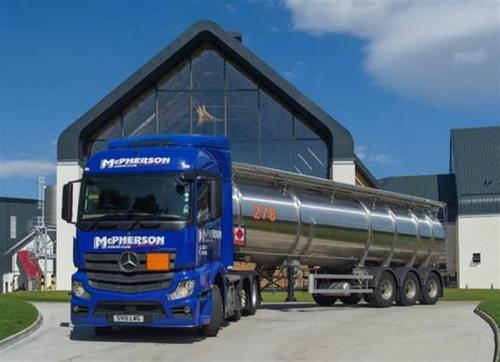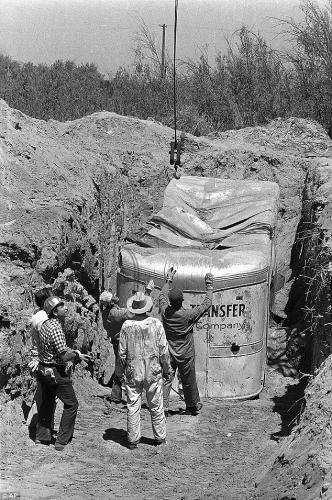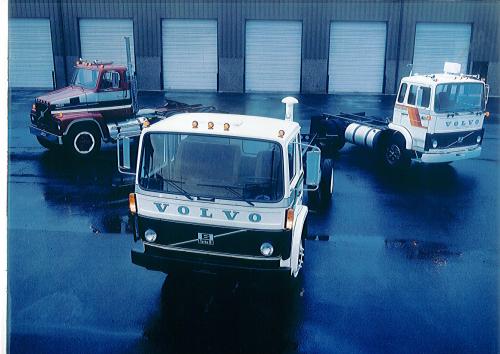
kscarbel2
Moderator-
Posts
18,927 -
Joined
-
Days Won
114
Content Type
Profiles
Forums
Gallery
Events
Blogs
BMT Wiki
Collections
Store
Everything posted by kscarbel2
-
Australia is at the equivalent of Euro-5. One can use dual DPFs, or only SCR. Importantly, note that CAT's C15 is using high pressure common rail fuel injection (2,200 Bar / 32,000 psi), like the leading European engine makers. For Euro-6, Scania and Iveco are offering "only SCR" engines..........no EGR but they have a DPF because there are occasional moments of need.
-
Looking to replace my tractors in my fleet for new units
kscarbel2 replied to Marcel67's topic in Odds and Ends
I note how you asked this new Volvo generation Mack brand salesman a valid question, and now many days later, he has yet to answer you. As the "Division Operations Manager," so anxious to sell a Mack brand truck, I'd expect him to set a good example to his salesmen by quickly responding to customer inquiries. In the days of the former Mack Trucks, our knowledgeable veteran salesman would immediately provide you with an answer to such a question, or within 24 hours for something out-of-the-ordinary. -
Woman, 25, murders her father AND daughter WFTV 9 / August 3, 2015 A 25-year-old Lakeland, Florida mother murdered her own father and her daughter, hid their remains in a neighbor's shed, then made up a story about them running off to Georgia. Cheyanne Jessie killed her 50-year-old father Mark Weekly and her six-year-old daughter Meredith, then waited more than a week before reporting them missing, detectives say. The pair's remains were found in plastic boxes on a neighbor's property in Lakeland, Florida, late Saturday night, some 200 yards from Weekly's home. Investigators say she killed Meredith because she was getting in the way of her relationship with a new boyfriend. It is not clear why she would have killed her father as well. Polk County Sheriff Grady Judd said Cheyanne Jessie killed Weekly and Meredith Jessie at Weekly’s home, then used a shovel to put them into two bins before driving the remains 200 yards to the landlord’s house, who was away, and put the bins in a shed. Deputies serving a search warrant discover blood-stained floors and furniture with slash marks. Judd said the house reeked of a foul odor, and Cheyanne Jessie claimed there had been a dead raccoon under her porch. "Nothing is more horrific than the murder of a child, except when it’s done by a parent," Judd said. Judd said a gun and knife were used in the killings, but they are waiting for the results of the autopsies to determine exactly how Weekly and Meredith Jessie died. "This is the face and (these are) the eyes of a cold-blooded murderer that not only murdered them on the 18th of July, but left them in the residence for many days," Judd said. Cheyanne Jessie is charged with two counts of first-degree murder and one count of tampering with evidence. .
-
Four relatives beat pregnant Texas girl, 14, into delivering stillborn baby, dispose of remains on charcoal grill New York Daily News / June 3, 2015 Four relatives have been charged after a 14-year-old girl raped by a family member was beaten and kicked into delivering a stillborn baby which was disposed of on a charcoal grill. The un-named victim was repeatedly assaulted between January and March 2013 when she eventually gave birth to a stillborn baby at the house in Pleasant Grove in Dallas, Texas. Lonnell McDonald, 27, Sharon Lee Jones, 45, Cedric Jones, 27 and Cecila McDonald, 25, have all been charged with engaging in organized crime. According to Dallas News, the 'underlying crime' is aggravated assault with a deadly weapon. The grand jury indictments in this case allege that the deadly weapon was the four defendants' hands and feet. At the time of their arrest, they were accused of trying to cover up the incident by burning the dead infant's body on a charcoal grill before disposing of it in an unknown location. According to court documents, the young girl told Dallas Police that she was sexually assaulted by a member of her family in August 2012, but did not report the abuse because she was 'embarrassed'. The suspects discovered the girl was pregnant in January 2013 and began attempts of forcing the victim to abort her baby. The victim came forward to police in May 22 when she made a full statement to officers. According to an affidavit the teen was allegedly given 'multiple doses' of birth control pills as well as emergency contraception pills and cinnamon tablets. When the pills failed to abort the baby, they are accused of pinning the girl down while Lonnell McDonald 'repeatedly bounced up and down' on the girl as well as kicking her. The final assault, according to one witness who accompanied the girl to police, lasted six hours, it is said. It is alleged that the suspects wanted to dispose of the body in case Dallas Child Protective Services came and took away other children from the house because of the initial sexual assault on the victim. The affidavit claims that Cecllia McDonald told the girl: 'You ain’t about to get my kids taken away from me.' The attack continued until the girl started bleeding heavily and delivered a stillborn baby about two hours later. The affidavit claims the infant's body was then burned on a charcoal grill. According to Dallas News, rape suspect Robert Joseph Cayald, 22 has not been indicted. He was arrested on charge of aggravated sexual assault and, along with the other four defendants, remains in jail on $150,000 bond.
-
Where did you get the part number for the set (301SQ31C)? From the good folks at Watts Mack? Did you use the 1QHA number stamped on your front axle? Most of those old set numbers are superceded to multiple items (you have to order the set items individually).
-
In the sense (at the very least) of the engine being the CAT C15 and the emissions solution, the Australian market long haul CAT trucks are not at all the same as the North American CAT vocational trucks.
-
Transport Engineer / August 3, 2015 Spirits haulage firm McPherson has taken delivery of its first Mercedes-Benz truck for more than five years, an Actros 2545 tractor, and this will be joined by another Actros in October. Supplied by Mercedes-Benz Commercial Vehicles Aberdeen, the 2545 has a StreamSpace cab and is powered by a 449bhp straight-six engine, with PowerShift 3 automated transmission. The second Actros will be a 2551 Bigspace, with 510bhp engine. Based in Aberlour, Speyside, McPherson runs a 200-strong fleet of tractors, which pull polished steel tankers, hydraulic double-deckers and bulk tipping trailers. Recently, its trucks have been acquired through two other manufacturers, but the determination of the dealership and the opening of a Mercedes workshop in Nairn swung the firm's decision: "We now have a dependable dealer that's within easy reach and that provides excellent back-up," says fleet engineering director Ian Jamieson. "In its first three months on the road, the Actros has performed faultlessly in what is a demanding role, negotiating the narrow and undulating roads of Speyside and accessing distillery sites which can be very tight. "The truck is also well liked by its driver and is showing improved fuel efficiency against our current fleet results." McPherson's trucks are specified to ADR standards for the carriage of Class 3 flammable liquids. The operator has also fitted a catwalk and large grab handles to the rear of the cab, and a Brigade camera system giving the driver all-round views, including the fifth wheel. .
-
CAT Press Release / August 3, 2015 Early Success for New Triples-Rated CT630HD Little more than a month after its bold debut at the Brisbane Truck Show, the new triples-rated CT630HD model from Cat Trucks has spearheaded a hugely successful 2015 Perth Truck and Trailer Show for West Australian Cat dealer WesTrac. “We knew there would be plenty of interest in the CT630HD but the level of enquiry for the full range of Cat trucks was beyond our best expectations,” said an emphatic Peter Calligaro, WesTrac Cat Trucks Business Unit Manager. “There were two HDs on our stand and both were sold even before the show doors opened.” Holding pride of place on the WesTrac stand was the first CT630HD sold in Australia, bought by Sean Carren, founder and managing director of high profile Perth-based transport company Goldstar Transport. WesTrac and several of its major customers including Sean Carren were strong advocates for the CT630HD and played significant roles in development of Cat’s new roadtrain specialist which carries a gross combination mass (GCM) rating up to 131 tonnes. Meantime, WesTrac’s second CT630HD show truck was snapped up just minutes before the Perth show was declared open. “I took a call from John Nicoletti, the head of Newmont Corporation,” explained a buoyant Peter Calligaro. “He’d briefly seen the truck the day before and in no uncertain terms told me he wanted that truck and not to sell it to anyone else.” Based at Merredin, around 260 km east of Perth, Newmont Corporation is a major multi-faceted agricultural enterprise with vast interests in grain and livestock. “Newmont has diverse transport needs which obviously include roadtrain triples, so John Nicoletti’s decision to purchase a CT630HD off the stand is certainly a strong endorsement for the features of the model,” Peter Calligaro commented. Cat’s tireless C15 engine is definitely one of the biggest benefits in the eyes of many operators, he adds. The driving force of all CT630 models, the trusted C15 is the only heavy-duty truck engine in Australia which does not require the burdensome cost and complexity of an EGR or SCR emissions control system. Also on WesTrac’s stand in Perth was a CT630SC, the purpose-designed model which continues to forge new business for Cat Trucks across Australia in B-double and B-triple applications. “That’s what made this year’s Perth show such a good event for WesTrac and Cat Trucks,” Peter continued. “The West Australian trucking industry covers a massive range of roles, from local trucks to east-west linehaul and of course, the double and triple roadtrain sector. “Now we have trucks for all those applications and while the CT630HD is an extremely important new model, there was no shortage of interest in the entire range from a broad cross-section of operators, including some who had travelled a very long way to see the trucks. “It was a great show for WesTrac and probably more to the point, a great show for Cat Trucks because we now have all bases covered with purpose-built models,” Peter Calligaro concluded. Related reading - http://www.cattrucks.com.au/trucks/ct630hd/
-
Two brothers murder parents and 3 siblings with hatchet Associated Press / July 31, 2015 First-degree murder charges were formally filed Friday against two Oklahoma brothers accused in the stabbing deaths of their parents and three siblings. Robert Davis Bever, 18, and Michael John Bever, 16, were each charged with five counts of first degree murder in the July 22 deaths of parents David Bever, 52, and April Bever, 44, and siblings Daniel Bever, 12; Christopher Bever, 7; and Victoria Bever, 5. The 18-year-old was 'very forthcoming' during his confession but showed 'no remorse' for the bloodthirsty massacre. Instead, he told police that the murders were 'just the beginning' of a string of killings planned outside of the family. The brothers were also charged with one count of assault and battery with intent to kill involving multiple stabbings inflicted on a 13-year-old sister who survived the attack. First-degree murder is punishable by life in prison or death, but Kunzweiler has said the maximum sentence facing the younger brother if he is convicted of first-degree murder is life in prison or life in prison without the possibility of parole. While the death penalty is legal in Oklahoma, the U.S. Supreme Court in 2005 banned the execution of anyone under the age of 18 at the time a crime was committed. Officers responding to a 911 call placed from inside an upscale home in the Tulsa suburb of Broken Arrow found blood on the front porch and heard a voice inside crying out for help, authorities said. Officers entered the residence and found the 13-year-old girl lying on the floor with multiple stab wounds. The assault charge alleges that the brothers used a knife to stab the girl "multiple times with such force that was likely to produce death." The girl, according to Robert Bever's arrest report, named Robert and Michael Bever as the people who attacked her and the rest of her family. A 2-year-old girl was found unharmed in an upstairs bedroom and has since been placed with relatives after initially being taken into state custody. A police dog tracked the two teens into a wooded area behind the family's home shortly after officers arrived on the scene, and two knives and a hatchet were discovered inside the home.
-
17-year throws newborn child away into dumpster Associated Press / July 31, 2015 A newborn baby girl who was found alive in a dumpster in western Kentucky remained in a hospital Friday, and a teenager was charged with attempted murder. The McCracken County sheriff's office said the baby was in stable condition after being found by a man Thursday afternoon. "What alerted him was he heard a loud noise outside," Sgt. Darrin Frommeyer of the sheriff's office said Friday. The man said he went outside, saw a young man walking away from the dumpster, walked over to it and heard a baby crying, Frommeyer said. When he opened the dumpster, he found the baby and called authorities. A 17-year-old boy was detained later and charged with attempted murder, first-degree criminal abuse and tampering with physical evidence, Frommeyer said. The teen is the boyfriend of the baby's 15-year-old mother, who was taken to a hospital with bleeding hours after the baby was found, Frommeyer said. The boyfriend confessed to police what happened. Officials don't know whether the 17-year-old is the baby's father. The mother lives with her mother and sister in an apartment near the business where the baby was found, and the boyfriend lives with his aunt, Frommeyer said. The girl's family told authorities they didn't know she was pregnant.
-
There are two CAT truck stories going on in the world. Down in Australia where CAT long-haul trucks are being marketed, the Navistar version of the MAN D26 is available (dubbed CT13), BUT the engine they are actually promoting is the CAT C15........and that's a "road engine" as you say. I've had little interest in the North American CAT vocational truck effort because, frankly speaking, the CT660 looks like a Tonka toy (Having said that, the newer CT681 looks purpose designed, if somewhat dated in appearance), and CAT U.S. flubbed the launch. But the effort in Australia is being attempted in the right way. I can't predict the future for CAT Australia, but my hat is off to the people down there. http://www.cattrucks.com.au/trucks/ct630hd/#tab=3 http://www.cattrucks.com.au/wp-content/uploads/2013/11/P30669_Engine_Spec_Brochure_A4-Low-Res.pdf http://www.cattrucks.com.au/wp-content/uploads/2014/10/P40006_CAT_Brochure_r6.pdf http://www.cattrucks.com.au/category/testimonials/
-
2 men arrested for shooting and killing 4-year-old boy as he played with stuffed toys on lawn KTLA News / July 31, 2015 Two men were arrested in the killing of a four-year-old California boy who was shot while playing with a stuffed animal in his family's front yard. Darron Daniels, 20, and Maurice Kelley, 25, were taken into custody for investigation of murder and attempted murder after Daniel Munoz was killed, San Bernardino County sheriff's authorities said. Daniel was outside his family's house Wednesday in the inland city of Highland when shots were fired. The boy was taken to a hospital where he was pronounced dead. Investigators have not discussed a motive for the shooting. They said Friday they were looking for a four-door, 1990s white Toyota Camry with black bumpers. Sheriff's deputies declined to provide any additional information. Daniels and Kelley are expected to appear in court on Monday. Highland, a city of 54,000 people in the foothills 60 miles east of Los Angeles, has been grappling with a rise in violent crime. Last year, authorities arrested more than 100 people in a crackdown on gangs in the city, the Los Angeles Times reported. On Wednesday, Daniel was playing with a stuffed bear he called Superman while family members picked fruit and watered plants in the front yard. His mother, Yuliana Morales, had taken an elder sibling and cousins to an amusement park and promised the boy he could go next time. 'It's my fault for leaving him here,' she said. .
-
Man shoots neighbor and runs over her with lawn mower Yahoo News / July 30, 2015 A $1 million bond has been issued for a man accused of shooting his neighbor to death and then running her over with a lawn mower. According to the Huron County Sheriff’s Office, deputies were called at just after 11 p.m. and told that shots were fired at a home in the 4300 block of Kirkwood Drive Tuesday. When deputies arrived at the scene, Linda Ciotto, 62, was found with a gunshot wound to the head. She was pronounced dead at the scene. It was determined that Ciotto was using her lawn mower at the time of the incident. James Blair, 50, is accused of shooting Ciotto and then running over her left arm with the mower. Blair reportedly barricaded himself in his home after authorities arrived. The Mansfield ASORT team and the Richland County Hostage Negotiator’s Team were called to assist Willard police and fire departments. Blair stayed in his home for nearly five hours as negotiators tried to get him to surrender. Tear gas was then used in an effort to push him out of the home. He was arrested shortly after. Blair faces a charge of murder and is in Huron County Jail on $1 million bond. The case is being investigated by the Bureau of Criminal Investigation, and two search warrants were executed — one for Blair’s home and one for Ciotto’s home.
-
Out of control, Baltimore killings soar to a level unseen in 43 years Associated Press / July 31, 2015 Baltimore reached a grim milestone on Friday, three months after riots erupted in response to the death of Freddie Gray in police custody: With 45 homicides in July, the city has seen more bloodshed in a single month than it has in 43 years. Police reported three deaths — two men shot Thursday and one on Friday. The men died at local hospitals. With their deaths, this year's homicides reached 189, far outpacing the 119 killings by July's end in 2014. Nonfatal shootings have soared to 366, compared to 200 by the same date last year. July's total was the worst since the city recorded 45 killings in August 1972, according to The Baltimore Sun. Crime experts and residents of Baltimore's most dangerous neighborhoods cite a confluence of factors: mistrust of the police; generalized anger and hopelessness over a lack of opportunities for young black men; and competition among dealers of illegal drugs, bolstered by the looting of prescription pills from pharmacies during the riot. Federal drug enforcement agents said gangs targeted 32 pharmacies in the city, taking roughly 300,000 doses of opiates, as the riots caused $9 million in property damage in the city. Perched on a friend's stoop, Sherry Moore, 55, said she knew "mostly all" of the young men killed recently in West Baltimore, including an 18-year-old fatally shot a half-block away. Moore said many more pills are on the street since the riot, making people wilder than usual. "The ones doing the violence, the shootings, they're eating Percocet like candy and they're not thinking about consequences. They have no discipline, they have no respect — they think this is a game. How many can I put down on the East side? How many can I put down on the West side?" "You can't attribute every murder to narcotics, but I would think a good number" of them are, says Shawn Ellerman, Assistant Special Agent in Charge of the Baltimore division of the Drug Enforcement Administration. ----------------------------------------------------------------- Here’s a thought: Why not have our government establish an effectively “border” around our country’s perimeter, so as to turn off the flow of illegal and crime-stimulating drugs from Mexico and Latin America.
-
Parents charged with child neglect after their toddler daughters are found wandering around motel naked and hungry, and test positive for COCAINE Daily Mail / July 31, 2015 Two parents have been charged with child neglect after their lice-infested toddler daughters were found wandering around a motel in South Carolina naked, hungry and with drugs in their systems. The two girls, aged one and two, were discovered by an unnamed woman walking nude down a set of stairs at a Motel 6 in Chesnee on May 31. They reportedly told the passerby they were hungry. The woman then alerted staff members at the motel, who provided diapers, wipes and clothing for the toddlers. Workers subsequently spent 45 minutes searching, door-to-door, for their parents. The girls' mother, Cheryl Leeanne Lynn, 24, was reportedly discovered hiding in the bathroom of the family's motel room, while their father, Andrew Donovan Buff, 28, was also found in the room. The only available food was a jar of peanut butter, along with two bottles of water. The girls were taken into emergency state custody and given medical exams. While one of the sisters had pink eye, they both had lice. Shockingly, the two toddlers also both tested positive for cocaine. On Wednesday - nearly two months after the incident at the Motel 6 on Jones Road - Lynn and Buff were arrested by sheriff's deputies and each charged with two counts of child neglect. Lynn has been released from Spartanburg County Detention Center pending a court hearing. Buff, however, is being held at the facility on a $10,000 cash or surety bond, officials said. The father of two has a lengthy criminal history, including convictions for shoplifting. .
-
Broken-down motorist murders couple and wounds their daughter after they stopped to help Daily Mail / July 31, 2015 An 18-year-old Wyoming man who robbed and shot three members of a family after asking for roadside help told investigators he opened fire after one of the victims laughed at him, an FBI agent said in a court filing Thursday. Jason Shane, 51, and Tana Shane, 47, died in the Wednesday shooting in the small town of Pryor, Montana, FBI spokesman Todd Palmer said. Their daughter, 26-year-old Jorah Shane, was shot in the back when she tried to run away, and she is recovering in a Billings hospital, the woman's aunt, Ada Shane, said. The family are reportedly part of the Whistling Water tribe, the Crow Nation's largest clan. The statement by Special Agent Larry McGrail II was filed in U.S. District Court seeking a murder warrant for Jesus Deniz, also known as Jesus Deniz Mendoza, of Worland, Wyoming. Two FBI agents interviewed Deniz on Wednesday, and Deniz acknowledged shooting three people with a .22 caliber rifle and then driving away in their car, McGrail's statement said. 'Deniz told the interviewing agents that he shot the victims because he was getting tired of waiting around, and because the daughter had laughed at him,' the statement said. Deniz is being held in Park County, Wyoming, after police arrested him near Meeteetse, about 120 miles away from Pryor. A judge's signed warrant would begin the process of returning Deniz to Montana to face charges in the killing. U.S. Magistrate Judge Carolyn Ostby scheduled an initial court appearance for Deniz on Friday. Jorah Shane recounted to her relatives the events leading to the shooting. Her mother, Tana Shane, drove by a young man parked on the side of the road who told her he had run out of fuel, Ada Shane said. 'He's only 18, and he looked like an innocent boy,' Ada Shane said. 'Both my brother and sister-in-law have big hearts.' Tana Shane went by her house, picked up her husband and daughter, and they drove back to the stranded car, Ada Shane said. The man pulled a gun and held it to the temple of 51-year-old Jason Shane. He ordered the father to stop the car and told everybody to get out, Ada Shane said. He told the family to give him their money, but the family said they had only change because they recently returned from a religious revival in Window Rock, Arizona. The man told the family to start walking. Tana Shane told her daughter in their Native American language to run. Jorah Shane told her aunt that she heard a shot, started running then heard bullets whizzing by her head. She fell, heard another shot, and started running again toward a church just as a car was pulling out. She ran to the car, and the frightened driver leaped out, Ada Shane said. Jorah Shane jumped in the driver's seat and drove to her house with the shooter still firing at her, the aunt said. Jorah Shane was later hospitalized. A bullet had grazed her head and she had a gunshot wound to the back. She didn't know as of Thursday that her parents had been killed in the shooting, Ada Shane said. Related reading - http://www.bigmacktrucks.com/index.php?/topic/41155-the-us-is-bordering-a-war-zone/
-
California grants parole to kidnapper who kept 26 schoolkids hostage buried underground Daily Mail / July 31, 2015 A convicted kidnapper who kept 26 children and a school bus driver in a buried trailer has been granted his freedom - after the governor of California didn't object to parole. James Schoenfeld, 63, kidnapped the bus carrying the group then buried them alive in a chilling heist inspired by the film Dirty Harry. Schoenfeld confessed to carrying out the 1976 crime with his brother Richard and his friend Fred Woods. He was originally given a life sentence, which was commuted to allow the possibility of parole. This will now be granted to him after almost 40 years in prison. Governor Jeremy Brown could have denied the recommendation of Schoenfeld's parole board, but took no action. The passage of the deadline at midnight on Thursday means that the parole process will continue. The victims of the kidnapping had described the suffering they felt 39 years later in a heartfelt letter to the parole board. They expressed the desire for their captors to remain in jail. In 1976, the Schoenfeld brothers and Woods took the children, who were aged from five to 14, and bus driver Ed Ray from Chowchilla in the Central Valley to a quarry near Livermore. There they were held captive inside a buried, ventilated trailer stocked with mattresses, food and water. The victims eventually managed to dig their way out and escaped unhurt. Richard Schoenfeld was paroled in 2012. Woods was denied parole the same year but may have another parole hearing this fall. The kidnappers were influenced by the 1971 Clint Eastwood film Dirty Harry, in which the antagonist kidnaps a school bus of children in exchange for a ransom. The Schoenfeld brothers and Woods lured the bus driver by pretending their white van had broken down on the side of a road. The bus driver stopped to see if the occupants of the van needed help. But three masked men, later identified as brothers Richard and James Schoenfeld and Frederick Woods, stormed onto the vehicle, brandishing guns and forced Ray to the back of the bus. The children and Ray were loaded onto two vans and driven around for 11 hours, during which time the hungry, petrified youngsters soiled themselves and held each other in fear. The vans were driven to a quarry near Livermore, where the captives were forced into a buried trailer stocked with mattresses, food and water - and equipped with fans and ventilation. The kidnappers, all from wealthy Bay Area families, planned to ask for a $5million ransom for their hostages. Their plot, which they had worked on for 18 months, unraveled when they took a nap. The driver and older boys were able to stack mattresses to a hole in the top of the van. They pushed open a weighted-down metal lid and freed the children who had spent 16 hours underground. 'He was a courageous man,' victim Jodi Heffington-Medrano said of Ed Ray, the driver. 'He kept 26 scared children in line and made us feel safe.' But even when the hostages started to escape, they feared the men were waiting outside for them, she said. All three men received life sentences after pleaded guilty to kidnapping charges. Jennifer Brown Hyde, 48, who was nine years old when she was kidnapped along with her ten-year-old brother described the chilling memory and life long trauma she has endured. She asked the parole board not to grant James Schoenfeld his freedom. 'I was honestly brutal,' she said. 'I wrote that they buried me alive, they stole my childhood and caused me immense emotional pain over the years. It affected my life, my parents’ lives and my children’s lives. 'For me, it’s having to deal with hatred and anger toward other human beings, and that’s a struggle that almost 40 years later I still have to deal with. 'Until recently I slept with a night light. I have anxiety attacks when I’m in a confined space, and it’s a problem living in the South when we have tornado warnings and we have to take cover in storm shelters... They took away my ability to be free.' The kidnapping affected Hyde's ability to be a mother to two children since she did not have what she considers a normal childhood. 'You don’t go from being buried alive and thinking you’re going to die to having a normal childhood,' she said. 'I’m fortunate I’m not incarcerated or hooked on drugs, which is how some of the kids dealt with it. I’m as OK as a broken person can be.' They letting this nut go free and re-enter society??? Seriously??? .
-
When Freightliner Walked Volvo on a Leash – the US Market N10
kscarbel2 replied to kscarbel2's topic in Other Truck Makes
As I recall, 1987 was the last year the Brigadier was built solely by GM and badged as a GMC. In 1988, the last year, the fleet favorite Brigadier was still built by GM in Pontiac but was marketed by the Volvo GM Heavy Truck Corp joint venture for that one year, and badged WhiteGMC. Then it was effectively replaced by the horrible (my opinion) decontented White-based WG in 1989, which had been introduced in 1988. I personally believe that the only reason Volvo agreed to sell the Brigadier in 1988 is because there was a lot of pressure from fleets. There were a few Brigadiers titled as 1989 models, but I suspect they were produced in late 1988. The WG was cheap, in EVERY sense of the word. But when the recession hit in the early nineties, a lot of fleets that had always purchased quality (Mack) rather than cheap trucks, such as Harwood Cochrane's Overnite Transportation, decided that cheap was suddenly right for them. So after a slow start, and blessed by the recession, the clumsy WG finally took off. The N10 never competed with the Brigadier. Brigadiers ran 290 to 350 horsepower engines, while the N10 was limited in LTL on-road applications at 253hp. And the Brigadier was a bargain for what you got, a favorite with fleet accountants. The N10 never sold well, not at all, but Volvo kept on hoping until they finally gave up. The Volvo Swedes absolutely hate admitting anytime they're wrong. -
15-year-old mother smothers newborn baby to death Associated Press / July 24, 2015 A teenage girl has been charged with murder after police said she admitted to killing the baby after giving birth Wednesday. Police say the teen killed her newborn baby on Abraham Flexner Way at Jewish Hospital, while visiting her grandmother at the hospital. Police received a 911 call that a teenager had given birth and killed the baby. The teenager admitted to smothering the newborn to death, putting the baby in her purse, and getting rid of evidence. The teenager is charged with murder, tampering with evidence, and abuse of a corpse. The murder took place in a hospital and it went undetected for hours -- until a friend of the teen got a text message from her about noon Wednesday. "I'm crying so much, please don't tell anyone," the girl read from her received messages. "I was in the hospital, my granny had another stroke," the teen continued. "So I walked outside and I overheated and now I'm in the hospital and around 4 this morning I pushed out the baby in the toilet. It was crying and opening its eyes and everything. I had to kill it." The girl said she told her friend to call the police, but the teen replied, "No, what the F. It's been dead since 4 in the morning, I told you I had to kill it." The 15-year-old mother also sent pictures of the baby to her friend. She told her friend she put her child in the dresser of the hospital room and planned to take her home, find her clothes and bury her. When she asked her friend to help, the friend called 911.
-
Teen suffocates newborn child, then going shopping Associated Press / July 30, 2015 A teenage girl suffocated her just-born baby boy before putting his body in a shopping bag, then going on a trip to a Victoria's Secret store the next day, prosecutors said as she was charged with murder Thursday. Tiona Rodriguez, now 18, pleaded not guilty, with her lawyer saying it was a stillbirth, not a killing. The indictment came nearly two years after Rodriguez was arrested on a $45 shoplifting charge at the lingerie store, where a security guard found the body in a bag Rodriguez was carrying. Prosecutors said their lengthy investigation revealed a girl who became a mother at 14 and was callously determined not to let anyone know she was having another baby. "She knew she would be in big trouble if her family found out, so she made a plan — to kill this baby," Manhattan Assistant District Attorney Rachel Ferrari said. "She had derailed her life once. She was not going to do it again." To carry out that plan, the then 17-year-old Rodriguez went to a friend's house Oct. 16, 2013, delivered in a bathroom, tore the 8-pound boy's umbilical cord with her hands and asphyxiated him, Ferrari said. In a text message at some point, Rodriguez used a vulgarity to describe the baby and added she'd "dig a hole" and "put it somewhere" adding an "LOL" — online jargon for "laughing out loud" — and "then we go eat iHop," the prosecutor said. After having her now 4-year-old son — a pregnancy unknown to her family until she went into labor — Rodriguez delivered again in 2012 in her bathtub, Ferrari said. That child didn't survive. Ferrari said that the circumstances of the death are unclear, but that Rodriguez had texted her then-boyfriend about smashing or burning the body to disguise what it was. Ward said that was a miscarriage. Prosecutors said the latest baby lived at least a few minutes after being born in 2013.
-
When Freightliner Walked Volvo on a Leash – the US Market N10
kscarbel2 replied to kscarbel2's topic in Other Truck Makes
The Titan Tiptop was inspired by the US market, but far from a success, the effort never got off the ground. And back then, the Volvo drivetrain was immature. When Volvo first came over and would sign near anyone willing to take the franchise, they never sold many F86US in the US. But when Freightliner came into the picture, a trusted name, the F6 and F7 began to sell. But Volvo was always behind Mack's Mid-Liner range, which by the mid eighties had become the most popular medium truck (COE) in the U.S. market. I was thinking about you the other day when someone brought up the Seddon Atkinson 400 series......good truck in its day. . -
21-month-old toddler found decomposed in crib, father arrested Associated Press / July 30, 2015 A man who told police he put bags of garbage in his young daughter's room to mask the smell of her decomposing body was granted sole custody of the toddler during a divorce last year. Eric Warfel, 34, of Medina, a suburb south of Cleveland, was ordered held on a $1 million bond on Thursday after being charged with abuse of a corpse. He was arrested Wednesday after a cable television technician was allowed inside his apartment to upgrade the service and found the body of 21-month-old Ember Warfel in her crib. Warfel told police Ember died June 18 and he hadn't informed family members or anyone else about her death. Warfel put garbage in the dead girl's room to mask the smell and had moved into a motel with a 7-year-old daughter. Police found Warfel and the girl Wednesday at a shopping center in the Cleveland suburb of Westlake. An autopsy will be conducted to determine how Ember died. Additional charges are expected, police said. Medina police said Thursday that a substance suspected to be cocaine was found during a search of Warfel's hotel room. Warfel and his ex-wife, Malinali Galdamez, had another child who died. Five-month-old Erin Warfel died March 31, 2013, after being taken by paramedics to a hospital while in full cardiac arrest, according to an autopsy report. Her death was ruled as "sudden unexplained infant death." Warfel and Galdamez married Feb. 14, 2012. A divorce decree indicates the 7-year-old has the same last name as her mother. The girl was removed from Warfel and Galdamez's home before their divorce by the Cuyahoga County Department of Job and Family Services and moved in with Warfel's parents. Galdamez did not seek any parenting rights beyond limited visitations. There are numerous references in the divorce decree to her substance abuse problems. It was Galdamez's fifth marriage and Warfel's first. Medina Police Chief Patrick Berarducci said Galdamez lives somewhere in New York. Prosecutors asked for a high bond because they consider Warfel a flight risk. The magistrate said Warfel had previously discussed moving out of state. He told the magistrate Thursday that he last worked for an insurance company in 2012. The discovery of a young girl's decomposed body in a crib at an Ohio apartment is prompting authorities to take another look at her sister's death two years ago, the Medina County police chief said Friday. .
BigMackTrucks.com
BigMackTrucks.com is a support forum for antique, classic and modern Mack Trucks! The forum is owned and maintained by Watt's Truck Center, Inc. an independent, full service Mack dealer. The forums are not affiliated with Mack Trucks, Inc.
Our Vendors and Advertisers
Thank you for your support!











